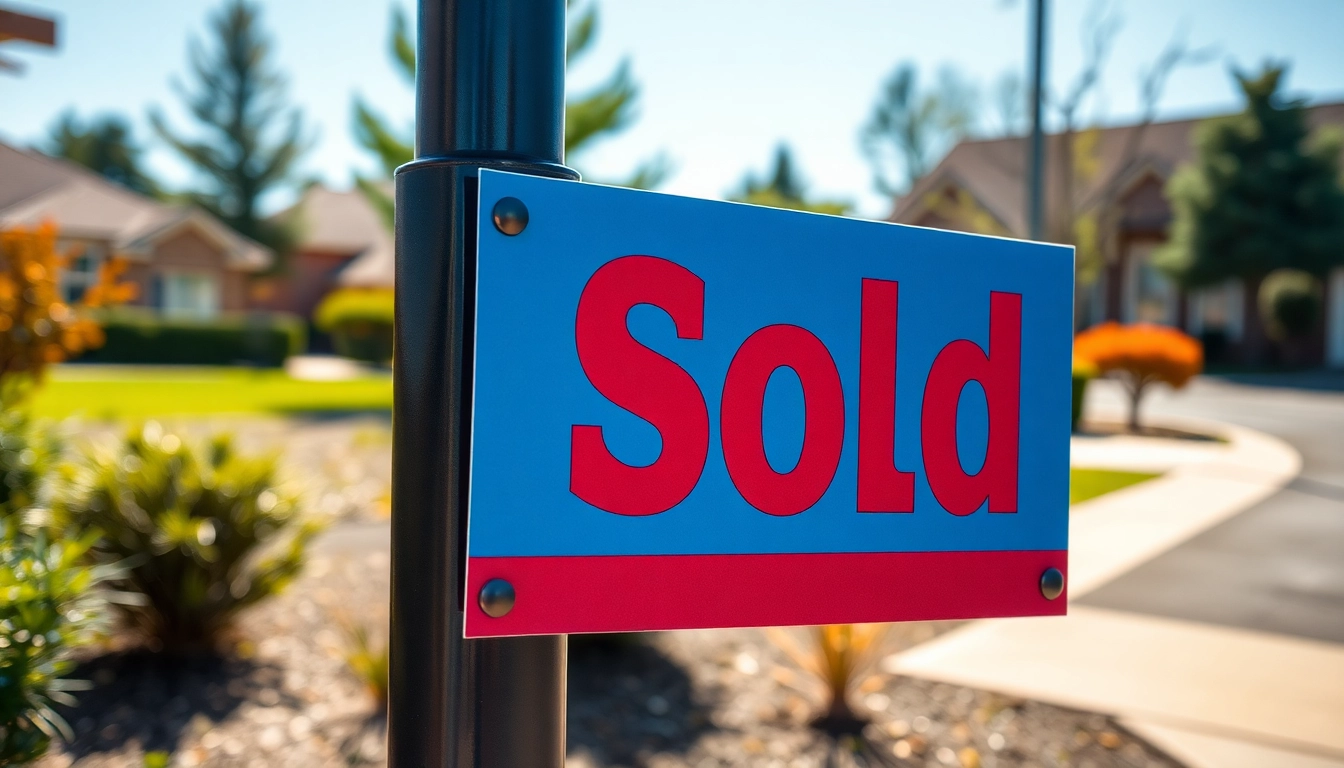Understanding the Significance of a Sold Sign in Real Estate
In the dynamic world of real estate, visual cues play a crucial role in facilitating transactions and building buyer confidence. Among these, the sold sign stands out as a universal symbol indicating a property’s successful sale. Historically, sold signs have served as tangible proof of an active and thriving market, fostering transparency and trust among buyers, sellers, and agents alike. Their presence on a property not only signals a completed transaction but also influences perceptions of neighborhood desirability and market activity.
Beyond their functional purpose, sold signs have a psychological impact that extends into marketing and branding domains. For buyers, a visible sold sign can create a sense of momentum and confidence—implying that others have found value in the property, thereby stimulating further interest. For sellers and agents, it acts as a badge of credibility and success, reinforcing a reputation for closings and market expertise. Today, modern trends have added layers of sophistication, with digital integrations, custom designs, and innovative materials, reflecting evolving consumer preferences and technological advancements, ultimately enhancing the effectiveness of sold signs in real estate marketing.
Design and Customization Options for Sold Signs
Material Choices: Plastic, Wood, Metal
The core of a compelling sold sign begins with choosing the right material. Plastic signs—such as corrugated or vinyl—are lightweight, durable, weather-resistant, and cost-effective, making them a popular choice for both short-term visibility and large-scale deployment. Wood signs, on the other hand, offer a rustic and personalized aesthetic, ideal for luxury properties or boutique agencies seeking a handcrafted appeal. Metal signs, typically made from aluminum or steel, bring durability and a premium feel; they withstand harsh weather conditions while maintaining a sleek appearance, making them perfect for long-term displays and upscale markets.
Color Schemes and Branding Integration
Color schemes are vital in ensuring the sign captures attention and aligns with your branding identity. Bright, contrasting colors like red and white or yellow and black are proven to boost visibility from a distance. Incorporating your company’s color palette solidifies brand consistency. Custom branding involves adding logos, taglines, and specific fonts, which not only reinforce brand recognition but also craft a professional impression. Carefully designed color schemes and branding elements can significantly impact how the sold sign attracts attention, communicates professionalism, and ultimately influences buyer decisions.
Personalization Features: Logos, Contact Info, Unique Graphics
Personalization transforms a standard sign into a marketing tool tailored to your business. Embedding your logo helps lock in brand identity, while prominently displaying contact information facilitates immediate lead capture. Unique graphics, such as house icons or directional arrows, enhance clarity and visual interest. Advanced options include QR codes that link to property websites or agent contact pages, providing instant access to detailed information. These features blend aesthetics with functionality, ensuring that your sold sign not only marks a successful sale but acts as a powerful marketing asset.
Best Practices for Using Sold Signs Effectively
Placement Strategies on Properties
Effective placement maximizes visibility and impact. The sign should be positioned at eye level and in an unobstructed view, ideally near the street curb or driveway entrance where passing traffic and pedestrians can easily see it. For corner lots, placing signs on multiple sides increases exposure. Ensuring the sign is well-lit or visible during dusk hours can enhance visibility. Consider local regulations or homeowners’ association rules regarding signage placement, ensuring compliance and avoiding potential legal issues.
Timing and When to Put Up a Sold Sign
Timing is crucial in leveraging the full potential of a sold sign. Typically, the sign should go up immediately after the property is under contract to create buzz and showcase activity. This helps establish credibility and attracts potential buyers who might still be considering offers or other properties. Some agents prefer to wait until closing to prevent premature disclosure, but proactive visibility often accelerates market perception and future listing momentum. Coordinating placement with other marketing efforts ensures maximum return on your signage investment.
Legal and Regulatory Considerations
Legal compliance is a fundamental aspect of using sold signs. Different jurisdictions may have specific regulations about sign size, placement, and permissible wording. For example, some areas restrict on-premises signage during certain hours or limit the number of signs allowed per property. It’s essential to verify local ordinances and obtain necessary permits to avoid fines or removal notices. Additionally, adhering to fair housing and advertising laws ensures that signage practices do not unintentionally discriminate or mislead prospective clients. Staying informed on regulations helps protect your reputation and ensures smooth operations.
Innovative Features and Technologies in Sold Signs
Magnetic and Adhesive Options for Quick Changes
Modern sold signs incorporate magnetic backing strips or adhesive overlays, enabling quick and clean updates. Magnetic signs are particularly popular because they allow agents to change messages—like “Sold” or “Under Contract”—without damaging the sign surface. Adhesive stickers or overlays offer similar convenience, with designs that adhere securely yet can be removed or repositioned as needed. These features streamline workflow, reduce labor costs, and prevent wear and tear, ensuring that signs remain professional looking throughout their usage lifespan.
LED and Illuminated Sold Signs for Visibility
Illuminated signs, especially those with LED technology, enhance visibility during dawn, dusk, or nighttime, making your property stand out no matter the hour. LED signs are energy-efficient, durable, and customizable in terms of color and brightness. They can incorporate flashing or steady lighting modes, capturing attention more effectively than static signs. This technology is especially advantageous in competitive markets or urban settings where visibility is paramount.
QR Codes and Digital Integrations for Instant Info
Embedding QR codes directly onto sold signs allows prospective buyers or agents to scan and access detailed property information, virtual tours, or contact forms instantly. Digital integrations extend beyond QR codes; some signs are equipped with Bluetooth beacons or NFC tags, providing a more seamless connection to your online listings or agent contact info. These innovations not only modernize the signage but also significantly boost engagement rates, providing a bridge between physical and digital marketing channels.
Measuring Impact and ROI of Sold Signs
Tracking Leads Generated from Sold Signs
To evaluate the effectiveness of your signage, implement methods to track inquiries originating from sold signs. Techniques include unique phone numbers, URL tracking with specialized landing pages, or follow-up scripts for inquiries referencing specific signs. Analyzing these metrics reveals which signs or locations generate the most leads, informing future placement and design decisions. Advanced CRM systems can integrate sign-based tracking, providing comprehensive data on lead sources and conversion rates.
Designing for Maximum Visibility and Impressions
Visual impact is critical. Using bold fonts, high-contrast colors, and clear messaging ensures quick comprehension by passersby. Strategic placement at eye level and in high-traffic areas increases impressions. Additionally, understanding local demographics and traffic patterns allows customization for maximum reach. Larger signs with simple, direct messaging tend to generate more attention, especially when combined with digital enhancements like lighting or QR codes.
Case Studies of Successful Sold Sign Campaigns
Case studies offer insight into best practices and tangible results. For example, a real estate agency that redesigned their sold signs with vibrant colors, strategic placement, and digital integrations saw a 25% increase in buyer inquiries within three months. Another success involved using illuminated signs in urban districts, which doubled their visibility and led to quicker sales cycles. Analyzing these cases underscores the importance of combining creative design, strategic placement, and technological innovation to maximize impact and ROI.



